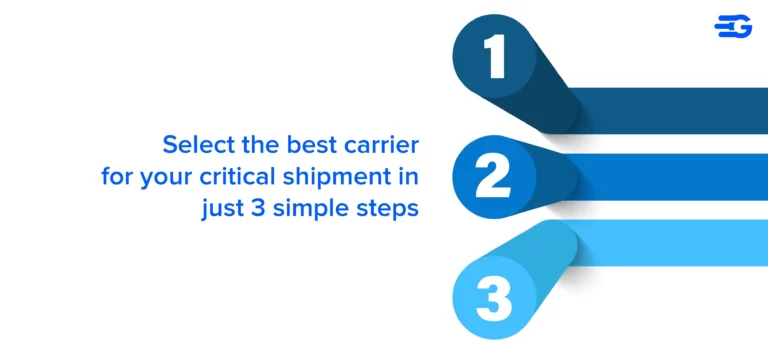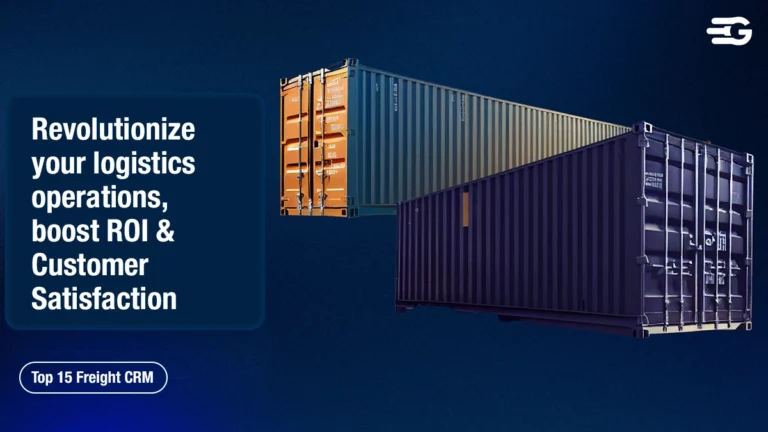Logistics Planning: What is it, Importance and Strategies?
Effective logistics planning is essential for businesses handling large shipments through freight forwarders. It ensures smooth supply chain operations, reduces costs, and meets customer expectations. In this blog, we explore the meaning, importance, benefits, challenges, and strategies of logistics planning, offering practical steps and insights tailored for enterprises.
What is Logistics Planning?
Logistics planning refers to the strategic process of managing the movement, storage, and delivery of goods across the supply chain. This involves coordinating every element to ensure seamless operations and cost efficiency. Key aspects include:
- Transportation management: Selecting the most efficient routes and reliable carriers to minimize costs and delivery times. This aligns closely with strategies like route optimization, which plays a key role in optimizing supply chain operations.
- Inventory control: Balancing stock levels to prevent shortages or overstocking while maintaining cash flow.
- Supplier coordination: Establishing reliable partnerships to reduce lead times and avoid disruptions.
- Demand forecasting: Using data-driven insights to predict future requirements and align supply with market demand. Advanced forecasting tools are vital for maintaining optimal inventory levels (6 Important Tips for Effective Logistics Management).
For businesses, effective logistics planning goes beyond basic operations. It ensures every supply chain link is optimized, leading to cost savings, higher reliability, and improved customer satisfaction.
For new business owners, logistics is just one part. Choosing the right legal structure, like an LLC, with the help of legal professionals ensures liability protection, tax benefits, and operational clarity. Combined, effective logistics and a suitable business entity build a strong foundation for success.
Why is Logistics Planning Important?
In today’s interconnected global supply chains, businesses must navigate tight deadlines, escalating costs, and high customer expectations. Logistics planning directly addresses these challenges by:
- Reducing operational costs: Streamlining processes and optimizing resource use to lower expenses.
- Improving customer satisfaction: Ensuring timely and accurate deliveries that meet or exceed expectations. A well-structured supply chain supports this goal, as detailed in the comparison of Supply Chain vs Logistics Management.
- Enhancing scalability and flexibility: Providing the adaptability needed to handle market fluctuations and support business growth.
An effective logistics plan ensures seamless coordination across the supply chain, enabling businesses to deliver consistent results, build trust, and reinforce reliability with their customers.
What Are the Benefits of Logistics Planning?
The benefits of logistics planning are extensive and impactful, especially for businesses managing large shipments. Key advantages include:
- Cost Efficiency: Streamlined routes and optimized inventory management significantly cut transportation and storage costs.
- Enhanced Delivery Speed: Well-coordinated logistics ensure faster deliveries, reducing delays and meeting customer expectations. The concept of linehaul logistics can significantly improve transit times.
- Minimized Waste: Accurate demand forecasting prevents overstocking, saving resources and cutting unnecessary expenses.
- Improved Customer Retention: Reliable delivery and consistent service build customer loyalty and enhance brand reputation.
- Environmental Sustainability: Efficient logistics strategies reduce fuel consumption and carbon emissions, supporting eco-friendly initiatives.
Focusing on these benefits helps businesses streamline their supply chains, maintain competitiveness, and meet both operational and sustainability goals.
Major Challenges in Logistics Planning
While logistics planning offers numerous benefits, businesses often face significant challenges that require strategic solutions:
- Global Supply Chain Complexity: Coordinating multiple suppliers, manufacturers, and distributors across borders can be daunting. Factors like differing regulations, languages, and time zones amplify the difficulty.
- High Customer Expectations: Modern consumers demand faster delivery and lower shipping costs, placing additional pressure on businesses to balance speed with profitability.
- Market Disruptions: Events such as natural disasters, political instability, or economic shifts can cause unexpected delays and disrupt the supply chain.
- Regulatory Compliance: Adhering to international trade laws and local regulations adds complexity and often incurs extra costs, especially for businesses operating in multiple regions.
- Sustainability Pressures: Companies are under increasing scrutiny to adopt eco-friendly practices, such as reducing emissions and optimizing packaging, without compromising efficiency or cost.
To overcome these obstacles, businesses need robust planning strategies, real-time visibility tools, and agile systems capable of adapting to disruptions and market demands.
How Logistics Planning Software Helps to Overcome Challenges
Modern logistics planning software streamlines and simplifies the complexities of managing supply chain tasks. These advanced tools play a crucial role in helping businesses overcome common challenges:
- Real-Time Tracking: Provides continuous visibility of shipments, enabling businesses to monitor progress, anticipate delays, and communicate accurate delivery timelines to stakeholders.
- Route Optimization: Identifies the most efficient transportation routes using algorithms and real-time data. This minimizes transit times, reduces fuel costs, and enhances overall delivery performance.
- Data Analytics: Offers actionable insights by analyzing historical and real-time data. This helps in demand forecasting, resource allocation, and identifying inefficiencies within the supply chain.
- Automation: Reduces manual errors by automating repetitive tasks such as inventory updates, order processing, and shipment scheduling. Embracing logistics automation is a critical step towards optimizing supply chains. This leads to faster and more accurate operations.
- Compliance Management: Ensures adherence to international and local regulations by integrating compliance checks into the logistics workflow, saving time and avoiding penalties.
- Sustainability Tracking: Monitors carbon footprints and suggests eco-friendly practices, aligning with environmental goals without compromising efficiency.
Platforms like GoComet stand out by providing businesses with centralized dashboards, predictive analytics, and user-friendly tools that improve decision-making and reduce operational costs. By leveraging such software, companies can ensure high service standards while staying ahead in a competitive market.
10 Things to Consider While Developing Logistics Plan
When building a logistics plan, businesses should prioritize efficiency, reliability, and adaptability. Here are ten critical considerations to create an effective plan:
- Define Clear Objectives: Establish specific, measurable goals like reducing delivery times, minimizing costs, or enhancing sustainability.
- Understand Customer Needs: Align logistics strategies with customer expectations, including delivery speed, packaging preferences, and order accuracy.
- Analyze Supply Chain Workflows: Identify inefficiencies, bottlenecks, and redundancies through a detailed review of current processes.
- Select Reliable Partners: Work with dependable freight forwarders, carriers, and suppliers who consistently deliver on time and maintain quality standards.
- Optimize Transportation Modes: Choose transportation methods that balance cost, speed, and environmental impact. Tools for route optimization can enhance cost efficiency while maintaining service quality.
- Implement Advanced Forecasting Tools: Use demand forecasting to anticipate future needs accurately and avoid overstocking or stockouts.
- Leverage Technology: Incorporate logistics software for real-time tracking, automated workflows, and enhanced visibility into operations.
- Ensure Compliance: Stay up-to-date with local and international trade regulations to avoid costly delays or penalties.
- Plan for Contingencies: Prepare for disruptions like supplier delays, weather issues, or market shifts by developing alternative strategies.
- Monitor and Continuously Improve: Use key performance indicators (KPIs) like delivery accuracy, transportation costs, and customer satisfaction to track performance and refine processes. Leveraging predictive analytics enables businesses to forecast and optimize logistics operations.
By addressing these factors, businesses can build a robust logistics plan that enhances operational efficiency, meets customer expectations, and supports long-term growth.
Examples of Logistics Optimization
1. Toyota: Just-In-Time (JIT) Production and Lean Manufacturing
Toyota’s logistics planning centers around its Just-In-Time (JIT) production approach, minimizing inventory while ensuring that parts arrive precisely when needed. Through JIT, Toyota reduces storage costs and minimizes waste, aligning production tightly with demand. This approach requires highly efficient logistics planning, as delays in any part of the supply chain could halt production. Toyota’s success with JIT is supported by strong supplier relationships, real-time data-sharing systems, and a highly coordinated network of transportation and warehousing.
Key Takeaways:
- Reduces inventory carrying costs and waste
- Requires close coordination with suppliers
- Depends on efficient transportation and real-time logistics tracking
2. DHL: End-to-End Supply Chain Solutions for Pharmaceuticals
DHL provides end-to-end logistics and supply chain solutions for the pharmaceutical industry, which demands precision, speed, and regulatory compliance. In this sector, DHL manages transportation, warehousing, and distribution while ensuring products maintain the required temperature and compliance throughout the supply chain. For DHL, logistics planning includes route optimization, regulatory management, and contingencies for rapid delivery in emergencies. They also employ cold-chain technology to keep temperature-sensitive medications within specific ranges during transit and storage.
Key Takeaways:
- Supports temperature-controlled supply chains for sensitive goods
- Requires compliance with strict health regulations and certifications
- Emphasizes route planning and rapid delivery solutions
3. Boeing: Multi-Tier Supplier Management
Boeing’s supply chain involves a vast, multi-tier network of suppliers for manufacturing aircraft. Each plane comprises millions of parts sourced from suppliers around the world, necessitating sophisticated logistics planning. Boeing uses tiered supplier management to track parts from production through assembly, ensuring traceability and maintaining strict quality control. Boeing also plans for logistics scenarios that reduce the risk of supplier delays, such as diversifying suppliers and using predictive analytics to manage supply chain risks effectively.
Key Takeaways:
- Involves multi-tier supplier coordination and quality control
- Manages high-value, precision parts with tight timelines
- Uses risk management and supplier diversification to maintain supply continuity
4. Shell: Global Logistics for Energy Distribution
Shell operates one of the largest and most complex logistics networks in the world to manage the distribution of oil and gas. Their logistics planning spans global shipping routes, pipelines, and overland transportation. Shell relies heavily on logistics planning for route optimization, safety compliance, and contingency planning. The company also uses data analytics to forecast demand and anticipate supply disruptions, ensuring timely delivery even in remote or challenging locations. Shell’s logistics planning also integrates environmental considerations to meet regulatory standards.
Key Takeaways:
- Manages large-scale distribution networks with strict safety protocols
- Utilizes forecasting and analytics to anticipate demand and mitigate risks
- Integrates environmental standards in logistics planning
GoComet and Essentra
Essentra, a global manufacturer and distributor, used GoComet’s logistics platform to overcome challenges in shipment tracking, freight selection, and data management. By centralizing data and streamlining processes, Essentra optimized its logistics, improving efficiency across the board.
Key Takeaways:
- Leveraged GoComet’s modules to strategically address logistics challenges and drive efficiency across global operations.
- Improved logistics visibility through a unified data and reporting platform.
- Transitioned from manual to automated tracking, enhancing operational efficiency.
- Streamlined freight choices for cost-effective and timely deliveries.
Creating a Logistics Plan: A Step-by-Step Guide
Developing a strong logistics plan is essential for ensuring smooth operations and meeting customer demands efficiently. Follow these detailed steps to create a robust logistics strategy:
- Analyze Current Operations: Break down every step of your supply chain. Identify inefficiencies, bottlenecks, and redundancies that hinder performance. Tools for supply chain mapping are invaluable for visualizing and resolving these issues.
- Set Measurable Goals: Define clear objectives such as reducing delivery times, cutting costs, or improving sustainability. Ensure these goals align with your overall business strategy.
- Choose Optimal Transportation Options: Evaluate different modes of transportation, comparing factors like cost, speed, and reliability. Use route optimization tools to make data-driven decisions.
- Forecast Demand Accurately: Leverage advanced analytics to predict future demand trends. Align inventory levels with expected sales to avoid overstocking or stockouts.
- Adopt Logistics Software: Utilize tools that offer real-time tracking, inventory management, and data integration to streamline operations and enhance visibility.
- Develop Contingency Plans: Prepare for potential disruptions such as supplier delays or natural disasters. Create backup strategies to maintain operational continuity.
- Track Performance with KPIs: Regularly monitor metrics like on-time delivery rates, transportation costs, and inventory turnover to measure success and identify areas for improvement.
- Encourage Cross-Department Collaboration: Ensure seamless communication between logistics, procurement, sales, and customer service teams. Collaboration reduces errors and enhances efficiency.
By meticulously following these steps, businesses can build a logistics plan that not only enhances efficiency but also fosters reliability and customer satisfaction.
Conclusion
Effective logistics planning drives success for businesses managing large-scale shipments. By focusing on clear strategies and leveraging the right tools, companies can optimize their supply chains and achieve long-term growth. For tailored solutions, consult GoComet today.
FAQs
What is the flow of logistics planning?
The flow of logistics planning starts with understanding customer needs and ends with delivering products. It involves procurement, storage, transportation, and monitoring to ensure seamless operations.
What is an example of logistics planning?
An e-commerce company optimizing delivery routes during peak seasons to reduce delays and costs is an example of logistics planning in action.
How can technology improve logistics planning?
Technology enhances logistics planning through:
- Real-Time Tracking: Visibility into shipments at every stage.
- Data Analytics: Insights for better decision-making.
- Automation: Reduced manual errors and faster processes.
What are the three major aspects of strategic logistics planning?
Strategic logistics planning focuses on:
- Supplier Coordination: Ensuring timely delivery of materials.
- Transportation Management: Selecting the best routes and modes.
- Inventory Control: Maintaining optimal stock levels.
Partner with GoComet to leverage our expertise and innovative solutions






